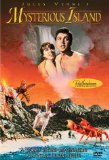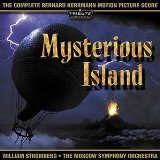The new complete soundtrack CD from the Tribute label
“Are we rising again?”
“No. On the contrary.”
“Are we descending?”
“Worse than that, captain; we are falling!”
“For heaven’s sake heave out the ballast!”
“There! the last sack is empty!”
“Does the balloon rise?”
“No!”
“I hear a noise like the dashing of waves!”
“The sea is below the car! It cannot be more than five hundred feet from us!”
“Overboard with every weight—everything!”
The 1961 second sound version of the film, the article dropped, begins as three men plan their escape from a Confederate prison in Richmond, Virginia. Escape, that is, in an air balloon. “What if there’s a whole regiment guarding it?” one man asks. “Just have to fight the whole regiment, Herbert,” Captain Harding replies. A new prisoner, Gideon Spilitt, inadvertently makes the group four.
And you’re in luck. John Morgan and William Stromberg, apparently joint creators of a new CD label, have recently released three, newly-recorded Herrmann scores. It could be argued that Island might not be as original as Fahrenheit 451, or as atypical as The Kentuckian (the other recordings), but certainly it is the most characteristically Herrmannian.
Present are the expected moans and groans, the dark, amber colors in tubas, double basses, contrabassoons and the like, the splash and hues of the instrumental colors of the impressionists, whom the composer admired. Too, there are the repetitive ostinatos—perhaps the Herrmann trademark—that correspond at the time to the minimalism of Philip Glass and Steve Reich. Maybe, even, Herrmann is an uncredited originator of the movement! Shhh-h-h—–! As for this absence of lush melodies and warm romanticism in the Victor Young or Alfred Newman vein, the late Elmer Bernstein said, “To create good film music, you don’t do it through a series of tunes necessarily; you do it by creating atmosphere, by manipulating the emotions of the audience through sounds and a kind of magic.”
The Moscow Symphony Orchestra under Stromberg plays with all the panache required, and then some. The Herrmann idiom is in their blood, it seems. Stromberg in his conducting and Morgan in this orchestral restoration (assisted by Anna Bonn and the conductor) have been careful to emulate—no, more accurate still, to copy exactly—the original score as recorded and conducted by the composer, recapturing every tempo, inflection, expression and nuance.
The recorded sound is full, vastly dimensional and realistic.
The seascape main title is arresting, less obviously repetitive than the tonal descent in the opening of Journey to the Center of the Earth, which Island most resembles. This music will be heard repeatedly throughout the film, ever-changing, if only slightly in most cases. That for the establishing shots of the siege of Richmond, also motif-filled, with subtle shifts of rhythm, continues while the four prisoners await their moment of escape. All the repetitions may seem alike. But listen carefully. There are differences. This music, here and throughout the score, has an hypnotic fascination that keeps one listening—and replaying the disc.
Journey to the Center of the Earth, which Island most resembles. This music will be heard repeatedly throughout the film, ever-changing, if only slightly in most cases. That for the establishing shots of the siege of Richmond, also motif-filled, with subtle shifts of rhythm, continues while the four prisoners await their moment of escape. All the repetitions may seem alike. But listen carefully. There are differences. This music, here and throughout the score, has an hypnotic fascination that keeps one listening—and replaying the disc.
A Confederate soldier (a Northern sailor in the novel), attempts to stop the escapees and becomes an unwilling occupant of the balloon basket, the fifth and last passenger.
One of the most interesting stretches of music (tracks are chronological), because it seems unending, is that for the flight of the balloon as it floats on and on, now rising, now slicing through rain, now battering storms and, finally, descending fatally. (Acute ears might detect in the moto perpetuo rhythm a striking similarity to a part of the first movement of Busoni’s seldom-heard Piano Concerto. Strange for a composer, Herrmann, who abhorred plagiarism.) Descending, descending . . .
“Everybody up on the ring!” Captain Harding cries. “Cut the basket loose!”
When four of the balloonists have survived the crash onto the island (Harding has earlier fallen into the sea), a fanfare of echoing, answering brass accompanies their own calls: “Captain Harding! Captain Harding!” As in any Herrmann score, the music will be reused later, reappearing in “The Cliff”: the fanfare, on a repetition, becomes distant and ominous. This segues into “The Cave,” one of the darker, more introverted, and longer, passages in the score. “Narration,” in which the captain recounts surviving on the island, is justified by a warm chorale for horns.
“Exploration” contains some enchanting music. The captain, having been found inexplicably safe, leads his marooned band through the forests where grow unusually large plants, across streams and, most picturesquely, thanks to a beautiful matte painting, over a log bridge. It is, perhaps, a respite from the often snarling and growling orchestra, now with endless harps, all bright and airy, as typically Herrmann as anything that has gone before.
 ng plant, was planned but never materialized.) The islanders encounter first the giant crab, with eight horns carrying the weight—and terror—of the music, aided by stabbing woodwinds, pounding timpani and continual cymbal crashes. Next in the chronology, the prehistoric bird—GIANT, of course!—actually appears to be an enormous just-hatched chick stuck atop enormous ostrich legs. Herrmann—again, remember he abhors borrowing—uses a bit of an organ fugue by baroque composer Johann Krebs (1713-80), beginning in the bassoons, shortly joined by other woodwinds, then much percussion. The music is as staccato as the jerky movements of Harryhausen’s animation. Because it is the fastest-moving of these creatures, it is the least successful.
ng plant, was planned but never materialized.) The islanders encounter first the giant crab, with eight horns carrying the weight—and terror—of the music, aided by stabbing woodwinds, pounding timpani and continual cymbal crashes. Next in the chronology, the prehistoric bird—GIANT, of course!—actually appears to be an enormous just-hatched chick stuck atop enormous ostrich legs. Herrmann—again, remember he abhors borrowing—uses a bit of an organ fugue by baroque composer Johann Krebs (1713-80), beginning in the bassoons, shortly joined by other woodwinds, then much percussion. The music is as staccato as the jerky movements of Harryhausen’s animation. Because it is the fastest-moving of these creatures, it is the least successful.Viewers may have reservations about the script. For one, the arrival of the two women (not in the novel) may seem an intrusion. The dressing of Elena in a miniskirt is blatantly anachronistic for a proper Victorian lady, though the growing friendship between Spilitt and Lady Mary is well handled. Captain Nemo’s arrival, despite Herrmann’s music, is a disappointment. A great Chief Inspector Dreyfus (Herbert Lom) does not a great Captain Nemo make, especially after James Mason’s portrayal some years before. Nemo fiddles while Rome burns, rather Nemo philosophizes while the volcano smolders.

I have yet to track down the score (or a recording) of the Krebs fugue. He wrote quite a few, so without further clues it will be difficult to find. Another little “Easter egg” in Herrmann’s score is his quoting from Rimsky-Korsakoff’s “Flight of the Bumblebee” during the bee sequence.